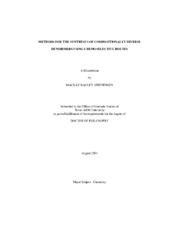Methods for the syntheses of compositionally diverse dendrimers
Abstract
Dendrimers are a unique class of macromolecules that present perfect branching on a molecular scale. The pattern of branching at the atomic scale is compared to the branching of trees, from whence dendrimers get their name. Dendrimers have been attractive synthetic targets for the past twenty years. The methods and building blocks used in the synthesis of dendrimers vary, but molecules of this class of polymeric materials all possess symmetrical branching emanating from the core. At each branch point the number of groups increases exponentially. Efforts directed toward the synthesis of dendrimers presenting multiple functional groups at the surface and within the dendrimer structure are described.
Methods are described which provide access to dendrimers in a one-pot per generation fashion, with triazines as the common moiety. Chemoselective routes utilize the temperature dependant substitution of cyanuric chloride to construct dendrimers, obviating the use of protected monomers or the need to manipulate functional groups during the synthesis. These methods are atom economical, as the only by-products are HCl and a base to scavenge it. The methods are efficient, with typical isolated yields of product in the middle to high ninety percent range, often on a multi-gram scale. Methods are described for conducting three separate reactions in a single pot. Specific emphasis is placed on structural control of the interior and surface groups of the dendrimers.
The synthesis of a G3 dendrimer of layered composition is described. The use of a different difunctional linkage group for each generation of dendrimer growth produced a G3 dendrimer with layered composition without the use of protecting groups or functional group interconversions.
A G3 dendrimer was synthesized presenting five different functionalities at the periphery on a 10 gram scale, resulting in approximately 70% overall yield. The peripheral groups are composed of orthogonal functionality, which can be independently and selectively unmasked or manipulated in the presence of the other functionality.
The syntheses of dendrimers incorporating the short linker hydrazine produce materials with interesting physical properties as well as a low ratio of carbon to nitrogen. The use of dendrimers in the construction of novel macromolecular constructs is also described.
Citation
Steffensen, Mackay Bagley (2004). Methods for the syntheses of compositionally diverse dendrimers. Doctoral dissertation, Texas A&M University. Texas A&M University. Available electronically from https : / /hdl .handle .net /1969 .1 /2724.


